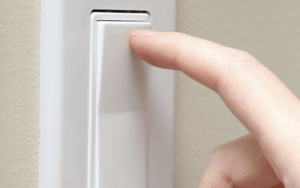How to Stop a Toilet from Running
Is a running toilet driving you crazy? There is no reason to let a toilet that keeps running annoy you and your family.
One of the items in our houses we take for granted the most is the toilet. We use it every day, and usually it works perfectly fine, but when it doesn’t work right, it changes the course of your day.
If you have a toilet that keeps running after you flush, you may have a lot of concerns. Will the toilet overflow? Is it costing me more money? What’s wrong with the toilet?
A running toilet usually doesn’t mean a serious plumbing problem, but it sure is annoying. Not to mention, a continuously running toilet can cost the average homeowner $1,000 more a year in water costs (on top of wasting 6,000 gallons of water each month).
How Does a Toilet Work?
Before you can fix your toilet, you need to know how it works. The best way to understand how toilets work is by examining it first hand. While each toilet is different, they all work on the same principle.
Take off the tank lid and give your toilet a couple of flushes. As you watch the tank empty and fill up, you’ll notice a few things:
A chain is lifted up every time you push down on the handle. This moves up the flapper at the bottom of the tank and allows the water to escape. When you release the handle, the flapper should cover this hole and the tank should fill back up with water.
A plastic float should be resting on the top of the water. This float signals the valve to let water in when the water is low and to stop letting water in once the water level is high.
There is an overflow tube in the middle of the tank. This drains water into the bowl when the water level gets too high.
Again, your best bet for diagnosing the problem is by removing the lid and watching all of this happen. You’ll be able to see what is going wrong, and what is responsible for your running toilet.
My Toilet Won’t Stop Running After Flushing, Now What?
This can be a minor inconvenience as far as plumbing problems go. But an inconvenience with a significant impact on your life nonetheless.
A toilet that keeps running can waste hundreds of gallons of water per day while hiking up your water bill, too. That’s why you’ll want to fix this problem as soon as possible.
You can call your local plumbing expert, like us at Climate Design if you live in Clearwater, Florida, or you can try to fix the problem yourself.
To fix the problem yourself, it first helps to know why your toilet won’t stop running.
6 Reasons Your Toilet Won’t Stop Running and How to Fix It
The reason it’s helpful to know the causes for your running toilet is that knowing the cause will help you fix it. Running toilets waste water and money, but luckily they’re an easy fix.
Learn the common causes toilets run, and how to easily fix your running toilet here.
1. Check for Leaks Around Your Toilet
If you suspect that your toilet is slowly leaking, there is no need to watch it for hours to confirm. All you’ll need is a few drops of food coloring.
Add enough food coloring to your toilet’s tank to change the water’s color. Do this right before you go to sleep after you are done using the toilet for the night.
The next morning, check and see if your toilet bowl water has changed colors.
If so, then water has been slowly leaking from your tank to the bowl overnight. Now all you have to do is figure out why.
2. Check the Toilet Flapper
Is water leaking through the toilet flapper inside the toilet tank? The most common reason for a running toilet is the toilet flapper not closing properly.
Over time, the flapper may become worn down or the rubber plug inside of the toilet tank loses its seal as it’s used. When this happens, it will no longer seal off the tank properly. You may need to get a new flapper from your local hardware store.
Remove the toilet flapper by unhooking the sides from the pins at the bottom of the overflow tube. What’s the overflow tube? It’s the open PVC pipe-looking tube in the center of the tank.
Inspect the flapper for mineral deposits, warping, discoloration, and other signs of damage. The bottom of the flapper should be smooth. If it’s not, or if there are signs of damage, you’ll need to replace the flapper.
You should be able to pull the flapper right off and you can take your old flapper to the local hardware store to make sure you get the right replacement. Flappers are fairly inexpensive. Pick the closest looking match of a “universal” replacement flapper, unless your toilet originally had an “adjustable” flapper installed.
To replace the flapper, fit in into place and attach the hooks on the side to the pins on the overflow tube. Then flush the toilet and see if it still runs after you flush.
3. Check the Water Level in the Tank
If the flapper isn’t the problem with your running toilet, the second most common cause is the water level inside of the tank.
In your tank, there is a water line and if the water is not filled up to this line, then the tank can cause your toilet to run.
Alternatively, when the water level is too high, water will constantly fill into the overflow tube and cause a constant running sound.
Open the back of your toilet tank and see if water is going into the overflow tube when the tank is full. The overflow tube is an open tube in the middle of the tank that connects the tank and the toilet bowl. If water keeps draining into the tube, you can adjust the water level by lowering the float ball.
A float ball fill valve will have a long arm attached to the fill valve. At the end of the arm, there’s a rubber ball-shaped float that rises or lowers with the water level.
The float height tells the fill valve to shut off when the tank is full. Shake the float ball to determine if there’s water inside it. If there is, replace the float ball.
You can lower the water level in the tank by adjusting the height of the float ball.
On top of the fill valve, there will be a screw attaching the float arm to the fill valve. You can adjust the height of the float by using a screwdriver or pliers to turn the screw.
Turn the screw counterclockwise to lower the water level or turn the screw clockwise to raise the water level.
Then, flush the toilet to let the water in the tank refill. You want the water to be around 1-1.5 inches below the top of the overflow tube. If it’s too high or too low, keep turning the screw in quarter turns.
This should address the water level issue.
4. Check the Fill Valve
Is your toilet still running even after trying the previous steps? The next thing to do would be to replace the fill valve.
This is something that most non-plumbers can do themselves, but it can be very time-consuming, especially if you haven’t done it before.
To replace the fill valve, first, turn off the water and empty the tank.
Next, disconnect the water supply line by unscrewing the lock nut on the outside of the toilet. Then, remove the old fill valve. Take the old fill valve with you to the hardware store so you can make sure you get the right replacement.
Fit the new fill valve in the old place and screw it in. Then, connect the water supply line.
Attach the fill tube to the water output nozzle at the top of the fill valve, adjust the float, and test.
5. Check the Toilet Chain
Your toilet chain’s job is to raise and lower the flapper at the bottom of the toilet tank, which controls whether the water in your toilet tank is flushing or not.
Open the back of the toilet tank and locate the chain. This chain should come off a metal arm in the toilet tank.
Toilet chain unhooked: At the bottom of the chain, there is a small metal hook. This hook can sometimes come undone. Normally, the hook should attach the chain to the flapper at the bottom. If it can’t form a seal, you’ll have a constantly running toilet on your hands!
Toilet chain too long: If your toilet chain is too long, it may be getting stuck under the edge of the flapper and prevent it from closing or making a seal. Trim the chain to lessen its slack.
Toilet chain too short: If your toilet chain is too short, the bottom flapper won’t lay flat even when the chain is fully extended. Sometimes the chain can become wrapped, this can be due to kinks in the chain. See if the chain on the flap at the bottom is caught or wrapped around the metal arm. Smooth them out, or you may need to buy a new chain altogether.
6. Check the Toilet Handle
If for some reason all the other fixes you’ve tried don’t work, give your handle a once-over. Does it stick when you press it? If so, it may be old and you need to replace it.
Contact Climate Design for Plumbing Services in Clearwater, FL
It can be very frustrating to deal with plumbing issues. And while the above steps can help you fix your running toilet problem, you may prefer to have a professional do it. Our experienced technicians are skilled at fixing almost all household plumbing problems.
You May Also Like

Why AC Tuneups Are So Beneficial to Your Comfort and Wallet
Living in Sarasota, FL, means embracing the sunshine and heat. It also means relying heavily on your air conditioner to stay comfortable.… Continue Reading Why AC Tuneups Are So Beneficial to Your Comfort and Wallet…

The Hidden Dangers of Ignoring a Shower Leak in Largo, FL
A shower leak is the last thing you want when you bathe in the morning to get you going or in the… Continue Reading The Hidden Dangers of Ignoring a Shower Leak in Largo, FL…

5 Tips for Preventing Electrical Accidents & Injuries
Electricity is ubiquitous in our day-to-day lives, making it easy to forget just how dangerous it can be. Household electrical accidents &… Continue Reading 5 Tips for Preventing Electrical Accidents & Injuries…

